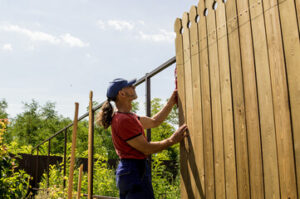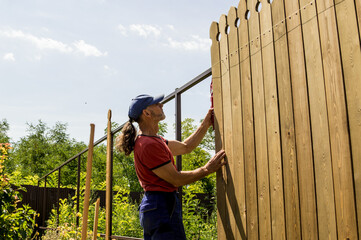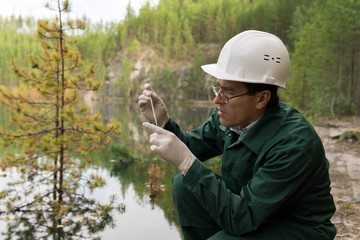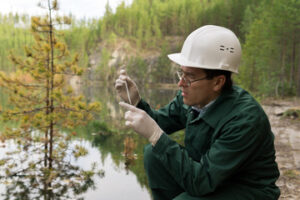A fence can provide you with a sense of security and privacy. However, installing a new fence can be an expensive project. Many factors contribute to the cost of fence installation. Materials Delays – The availability of certain materials can delay the timeline. This can be especially true for more rural properties, as material may need to be transported far away.
 Choosing a reputable Fence Company Rock Hill SC to erect your fence is important. You want to be sure that you choose a company with good quality workmanship and who is knowledgeable about fencing materials.
Choosing a reputable Fence Company Rock Hill SC to erect your fence is important. You want to be sure that you choose a company with good quality workmanship and who is knowledgeable about fencing materials.
A fence is more than just a safety feature; it can complement your home and add curb appeal. The right fence can frame your house and highlight its best features while hiding its flaws. It can also provide privacy, help you keep your pets and children contained in the yard, and increase property value. Before choosing a fence color and style, it’s important to consider your primary needs. Do you want to create a decorative boundary for your backyard or prevent pets from wandering into the street? What about top-notch security? The answer to these questions will determine the type of fence you need.
When choosing a fence, it’s important to identify your goals and what will make your home unique. You should also take into account the climate of your area, as some materials are better suited for certain conditions than others. For example, a wood fence is ideal for colder climates, while vinyl is a good choice for warmer areas. In addition, you should always consider how your new fence will impact the surrounding neighborhood.
Before you begin building a fence, be sure to find your property line and clearly mark it. This will help prevent disputes with neighbors and local officials. You should also ask your neighborhood association or municipal building code official about any covenants that govern fencing look, height, and material.
A professional will be able to guide you through this process and recommend the most suitable options for your property. You may also be able to buy a pre-made fence from a company that can save you time and money.
In order to prepare your property for the fence installation, you should clear away all items and debris that are in the way of the structure. For instance, you may need to remove a tree, relocate your electrical box, or move sprinklers. This will make the process easier for everyone involved and ensure that your fence is built properly.
You should also notify your neighbors about the upcoming fence installation. While it might seem awkward to discuss such a topic, it will help you avoid potential disputes. If your neighbor is in agreement with your fence plans, you will both be able to enjoy the benefits of your investment.
Preparing Your Property
When you’re ready to get started on your fence installation project, it is important to make sure that the site is free of obstructions and is prepared for the work to take place. This will help the crew members to do their job more efficiently and effectively, and it will also reduce the risk of any problems occurring during the construction process.
The first step in preparing your property for fence installation is to mark the property lines. This can be done in a variety of ways, but one of the most effective is to use wooden stakes that are placed 8 feet apart and run twine between them. This will create a visual outline of the property line, and it can be helpful to have this information available in case you need to discuss boundary issues with your neighbors or the local authorities. You may want to also make sure that you’re clear on the location of any underground utilities, such as gas, water, or electricity. This will prevent you from accidentally striking these lines and causing a serious problem for yourself or your neighbors.
If you’re going to install a wood fence, it’s a good idea to paint or stain the posts before the installation begins. This will protect them from the elements and keep them looking great for a long time.
Before you begin the installation process, it’s also a good idea to let your neighbors know what you’re planning and when you expect to start. This will give them a chance to come up with any concerns or suggestions they might have and avoid any potential problems down the road.
Finally, be sure that you’re aware of any zoning restrictions or covenants in your neighborhood that could restrict the style, height, or location of your fence. This can be especially important if you live in a community with an HOA, which can often dictate these things to you with very little room for wiggle. Having this information ahead of time can save you the hassle of having to redo the entire fence later on down the line.
Obtaining a Permit
If you live in a city, you are likely to need a permit to build a fence. This process varies from one place to the next, and it is best to find out exactly what is required for your area before beginning construction. This will help you avoid a costly mistake down the road and ensure that you are following the rules set forth by your municipality.
Some cities require you to submit a detailed site plan and some may have specific requirements, such as height limitations or distances from property lines. Others will have a more straightforward application process. Most cities, however, will require some form of notification to your neighbors. This can be in the form of a letter or a simple online notice. This is to prevent any disagreements between neighboring homeowners over the location and appearance of your new fence.
In some places, you must also make sure that you have located and marked any underground utility lines in the work area. This includes water, gas, electric, sewer, and telecommunications lines. Failure to do this could damage your property and/or injury to yourself or your workers. Contact your local utility companies before beginning any construction on your property, including installing a fence, is always a good idea.
If your property is in an easement, it is important to know if this is the case and take necessary precautions before constructing a fence. If you are building within an easement, you will need a permit and may need to provide a completed Easement Acknowledgement Form. It is a good idea to refer to your survey or recorded plat to see if there are any easements on your property.
It is also important to communicate with your neighbors before constructing a fence, even if it’s just to let them know you will work in their yard. Not communicating with your neighbors can lead to conflicts that are far more difficult to resolve once the fence is up. You may also need to check with your HOA if you live in an association community.
Choosing a Contractor
Selecting a company that will take the time to ensure your project is done right is crucial. Taking the time to make the right choice will save you money and headaches down the road.
Getting a referral from a friend or relative is one way to find a reputable and professional contractor. Another good option is to go online and check out the website of local fence companies. It would be best to look for a comprehensive site with contact information, work samples, free tips and information, and customer testimonials.
Ask the fence contractors you are considering what type of fencing they specialize in and whether they offer a warranty on their work. You should also find out if they are licensed, bonded and insured in your state. In addition, you should find out if they have any pending legal action against them.
If a fence company offers a very low price, it may be because they are cutting corners or using cheap materials. Despite saving cash upfront, you will most likely end up spending more in the long run because of the poor quality.
You should also find out how long the fence company has been in business and how much experience they have. The more experienced the fencing company is, the better their work will be.
Once you have found a reputable fence company, you should discuss the details of your project with them so that there are no surprises. This will help ensure that your fence is finished on time and at a price you can afford.
You should also ask the company whether they are responsible for obtaining permits and contacting utility companies to locate any underground lines that might be impacted by the construction of your fence. If this is not something that they handle, you will need to do so on your own.



 Testing for water contaminants is usually done using laboratory methods. Lab testing can provide accurate results, but it takes time. For quicker tests, home kits are often used.
Testing for water contaminants is usually done using laboratory methods. Lab testing can provide accurate results, but it takes time. For quicker tests, home kits are often used.